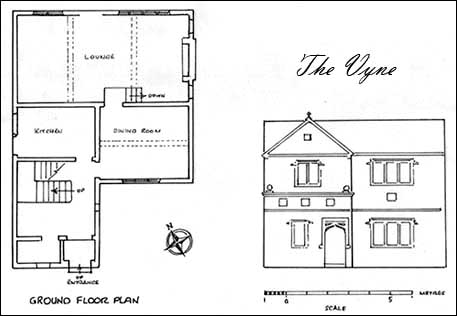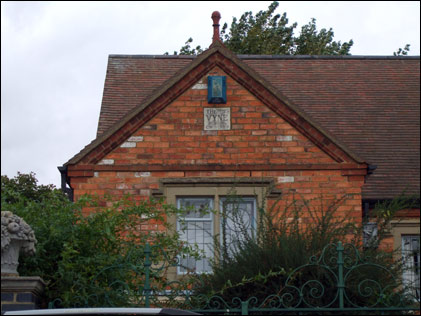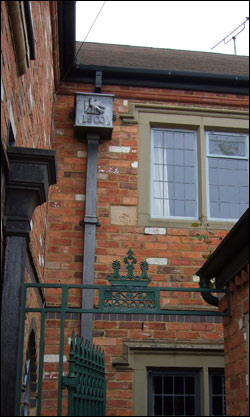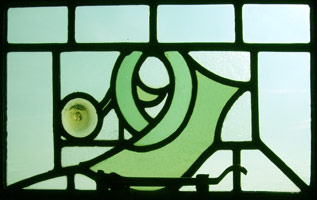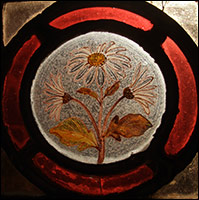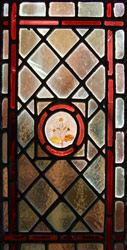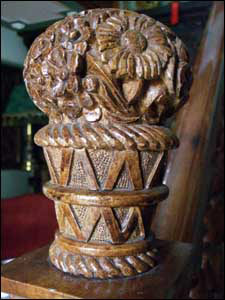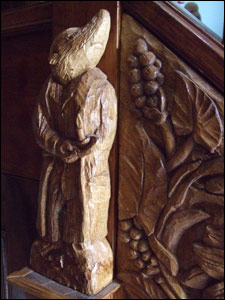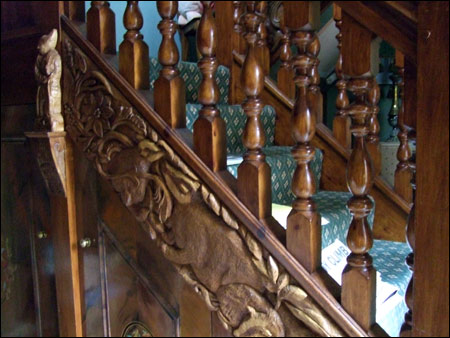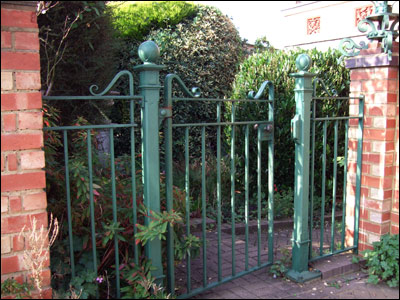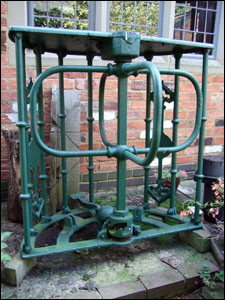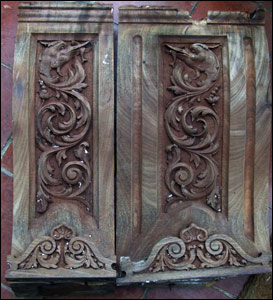|
|||||||||||||||||||
| Certificate in Architectural History - Early Houses and Castles (1999), Clive Wood |
|||||||||||||||||||
|
The Vyne
|
|||||||||||||||||||
|
|||||||||||||||||||
|
|
|||||||||||||||||||
Details to accompany coursework - The Vyne
A detached dwelling house designed to the specification of the present owner, built of reclaimed red brick and incorporating a number of reused materials, the bricks of Irthlingborough manufacture circa 1800. The house is L-shaped in plan and is best described elevation by elevation since there are features included to a greater or lesser degree from each viewpoint. Involved as I am in the present course, I suffer at times from a feeling of guilt when we discuss identifying buildings by features incorporated in them, and apologise for my building, which, though it would not deceive anyone with a modicum of architectural knowledge, does fool a number of people at first impression. The front projection is single story with a flat roof, felt covered, behind a parapet with a stone coping [reused Rushden Rectory 1860] and covered with dressed lead, in the facade are incorporated three terracotta or carved brick panels with various designs of stylised flowers and foliage, these are framed to left and right by a pattern of three bricks, two blue and one white. The parapet is divided from the lower brickwork by a stringcourse composed of two courses of old roofing tile above a course of blue bricks. Two stone balls on square bases are on the top of the parapet, one from Rushden Hall and one from Newnham Priory, the later covered with lead is heavily pitted from airgun pellets when used in its original position as a target! The South Elevation [main house] has only two small windows, framed in oak and glazed with lead lights composed of new glass but incorporating a Red lozenge of 1900 and two moulded pieces circa 1820, they have flat or Camber Arches above of stone. At the base of the gable is a string course of alternating white and blue bricks and towards the top a panel of eighteen bricks, also blue and white in panels of three.
|
|||||||||||||||||||
The front door is a six panelled late Georgian example with a Tudor shaped top as influenced by the Gothic fashion, with raised fielded panels while most of the other interior doors are typical framed and four panelled interior pattern with beaded panels in Pitch Pine circa 1890. [Note: Discarded into the back yard at Rushden Hall and run over by a lorry. Clive purchased, repaired and restored the door.] In the Dining Room there is a china alcove or niche, a semi-circular cupboard with a shell top, in this instance the shell falls from the top, consisting of fourteen ribbed segments but the interesting information, which of course is no longer visible is the construction of the shell, this is made of thirty six shaped pieces of wood of varying sizes that fit together exactly like a "chocolate orange", held together by rabbit glue and hand forged rusty nails. In the master bedroom a similar china alcove forms part of the panelling of the room, but in this instance the shell raises from the bottom and consists of five tapering panels divided by wooden 'ribs', the edge of the shell being scalloped, the whole piece being of a better quality, fluted flat pilasters with capitals and bases frame the interior and below is a cupboard of two doors, with fielded panels, the doors with 'H' hinges secured by handmade nails. The panelling all of raised and fielded pattern has a dado rail with horizontal panels below and corresponding upright ones above, the later being 5 feet by 3 feet, now in a stripped and waxed finish, it was originally made for painting and was a rich turquoise colour with Gold Leaf highlights. The panelling was removed from a first floor room in Newland, Northampton, circa 1740. In the lounge there is a fireplace, again based on a period style of the 15 cent, consisting of two stone columns with foliated capitals supporting a block and plaster hood, on this is fixed a cast bronze of the Royal Arms, coloured and gilded, supposedly the ‘By Appointment' plaque from the garage in north London which supplied the Royal cars for King George V. The door from the Dining room into the Lounge has a made up lead-light of various pieces including two of the Crests of Robert Vernon, 1st Baron Lyveden, President of the Board of Control from March 1855 to February 1858, the crests were part of the staircase window at Firmyn Woods, Brigstock and were removed when the Victorian wing was demolished in the 1970's, they are 'Vernon, a boar’s head erased, sable, ducally gorged or, and Smith a cubit arm, erect in armour, ppr, charged with a battle-axe sable, the hand grasping two wreaths of laurel pendent on either side, also ppr'. The Vyne was built to use up an accumulation of materials acquired at a time of wanton destruction; the panelled room cost me '20 Players', and that included a wing chair. Never a destroyer, it has given me a great deal of pleasure to have been around at the opportune time, when I could rescue artefacts and materials that would have been destined for the tip or the fire, and to give them a new lease of life, now of course given the fancy name of re-cycling. Reference sources:
|
|||||||||||||||||||
|
Since Clive wrote the above in 1999, he has continued to adorn various areas of his house. The staircase now has the carved panels and the finials affixed (pictured above), and a coving in the lounge exhibits his artwork in the form of Armorial Shields of the notable families in Northamptonshire. He continues to preserve items of Rushden's heritage.
|
|||||||||||||||||||
